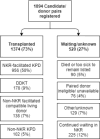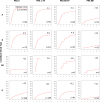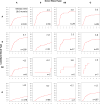Kidney exchange match rates in a large multicenter clearinghouse
- PMID: 29437286
- PMCID: PMC6082363
- DOI: 10.1111/ajt.14689
Kidney exchange match rates in a large multicenter clearinghouse
Abstract
Kidney paired donation (KPD) can facilitate living donor transplantation for candidates with an incompatible donor, but requires waiting for a match while experiencing the morbidity of dialysis. The balance between waiting for KPD vs desensitization or deceased donor transplantation relies on the ability to estimate KPD wait times. We studied donor/candidate pairs in the National Kidney Registry (NKR), a large multicenter KPD clearinghouse, between October 2011 and September 2015 using a competing-risk framework. Among 1894 candidates, 52% were male, median age was 50 years, 66% were white, 59% had blood type O, 42% had panel reactive antibody (PRA)>80, and 50% obtained KPD through NKR. Median times to KPD ranged from 2 months for candidates with ABO-A and PRA 0, to over a year for candidates with ABO-O or PRA 98+. Candidates with PRA 80-97 and 98+ were 23% (95% confidence interval , 6%-37%) and 83% (78%-87%) less likely to be matched than PRA 0 candidates. ABO-O candidates were 67% (61%-73%) less likely to be matched than ABO-A candidates. Candidates with ABO-B or ABO-O donors were 31% (10%-56%) and 118% (82%-162%) more likely to match than those with ABO-A donors. Providers should counsel candidates about realistic, individualized expectations for KPD, especially in the context of their alternative treatment options.
Keywords: ABO incompatibility; clinical research/practice; donors and donation; donors and donation: paired exchange; health services and outcomes research; kidney transplantation/nephrology; kidney transplantation: living donor; panel reactive antibody (PRA).
© 2018 The American Society of Transplantation and the American Society of Transplant Surgeons.
Conflict of interest statement
DISCLOSURE
The authors of this manuscript have no conflicts of interest to disclose as described by the American Journal of Transplantation.
Figures





References
-
- Gentry SE, S D, Simmerling M, Montgomery RA. Expanding kidney paired donation through participation by compatible pairs. Am J Transplant. 2007;7(10):2361–2370. - PubMed
-
- Gentry SE, M R, Swihart BJ, Segev DL. The roles of dominos and nonsimultaneous chains in kidney paired donation. Am J Transplant. 2009;9(6):1330–1336. - PubMed
-
- Ferrari P, C L, Ta J, Woodroffe C, DʼOrsogna L, Holdsworth R. Providing Better-Matched Donors for HLA Mismatched Compatible Pairs Through Kidney Paired Donation. Transplantation. 2016 [Epub ahead of print] - PubMed
-
- Montgomery RA, Z A, Ratner LE, Segev DL, Hiller JM, Houp J, Cooper M, Kavoussi L, Jarrett T, Burdick J, Maley WR, Melancon JK, Kozlowski T, Simpkins CE, Phillips M, Desai A, Collins V, Reeb B, Kraus E, Rabb H, Leffell MS, Warren DS. Clinical results from transplanting incompatible live kidney donor/recipient pairs using kidney paired donation. JAMA. 2005;294(13):1655–1663. - PubMed
-
- Ferrari P, H P, Cohney SJ, Woodroffe C, Fidler S, D’Orsogna L. ABO-incompatible matching significantly enhances transplant rates in kidney paired donation. Transplantation. 2013;96(9):821–826. - PubMed
Publication types
MeSH terms
Grants and funding
LinkOut - more resources
Full Text Sources
Other Literature Sources
Medical
Research Materials

